Foreign Films
Back to Contents of Issue: March 2004
|
|
|
|
by Richard Donovan |
|
|
Except that you don't get it, really. This quintessentially Japanese film was written, directed, produced and edited by two Westerners.
Firefly Dreams is the labor of love of John Williams and Martin Rycroft, and while it is their first fully fledged feature, they are confident that it won't be their last. Williams and Rycroft are the key foreign members of their Tokyo-based production company 100MeterFilms.
A deep and abiding affection for quality film has united them and their Japanese associates under a corporate moniker that is as playfully evocative as it is pragmatic. The name was inspired by the famous 100 meter wide Hisaya Street teeming with traffic in central Nagoya, the city in which they first arrived in Japan. But at the same time, 100 meters of celluloid doesn't go a long way in the film business, so, as Williams jokes: "It's about how much you can do with very little!"
But though the future of 100MeterFilms, like that of the Japanese industry in general, is far from certain, its very existence as a Western-run islet in the seas of Japanese media production is a minor miracle in itself.
Williams and Rycroft, both from the UK, differ starkly in background and temperament. Williams grew up in Scotland and Wales, while Rycroft is from the small city of Morecambe in Lancashire. Williams studied literature and languages at Cambridge; Rycroft earned a chemistry degree at Oxford. Williams brings an indefatigable creative energy and directorial vision to his projects, while Rycroft has a steadying hand and a producer's eye for contractual fine print. But both found themselves irrevocably altered by what they experienced in the cinema in their youth.
For Williams, seeing Werner Herzog's historical film Aguirre: The Wrath of God (1973) at the age of 14 was a turning point in his life. "I thought, this is what I want to do. It was the first time I was aware of the concept of directors, somebody who actually controls the film."
So Williams left. To start saving for film school, he found a job teaching English during the bubble era in Nagoya, where he met Rycroft.
Like most of his fellow students at Oxford, Rycroft had found no use for his chemistry studies, and he shared Williams's urge to leave his homeland. He worked at a variety of jobs in the US for some time before heading to Nagoya in 1988.
The revelation of his own naivete almost led Williams to give up on film altogether, but Rycroft, among others, encouraged him to give it one more try. His friend had been so impressed by Williams's emerging talent that he was prepared to pony up large amounts of his own money, as well as support him in a producing role. Rycroft had shifted from being an appreciator to a maker of films: "When we did Midnight Spin I got very keen. I saw a lot of potential."
"We were determined to have a theatrical release, sell overseas and have a film-festival strategy. But it was still very theoretical, just what I'd read about in books. We didn't know anybody."
Still, they knew their own hearts, and in 1999, Williams and his Japanese associate, graphic designer Kazuaki Kaneda, backed by Rycroft, formally established the 100Meter-Films company in Nagoya.
Kaneda, then a student at Nagoya University, had become friends with Williams when they co-ran the Amnesty International group there. "I realized he was a very good organizer, so I said, how about a film?" Williams had found another unwitting convert to the world of independent film production -- Kaneda would soon become one of the producers on Firefly Dreams.
But Williams says that the last-minute changes were not confined to the authenticity of the dialogue: "Structurally, a lot of it changed on the set." He contends that no director, no matter how experienced, can ever afford to be a total auteur. "It's really collaborative, film making. Of course a director should stamp their vision on the film, but you only do that if you have people pushing you to say what it is that you want, or in directions that you discover are actually right. Even the autocratic directors always work with really good people."
Another contributor Williams called upon to enhance the overall feel of the film seemed an unlikely choice: British composer Paul Rowe.
Williams has high praise for the actors themselves, many of whom were locals and worked for nothing. "They were all genuinely committed." While the core cast was composed mainly of young people caught up in the excitement of their first film, the producers had savvily cast veteran actress Yoshie Minami, then 84, in the role of a former starlet walking the tightrope of senility in a lonely country house. While the other actors rehearsed for several weeks, Williams only had 10 days with her.
"I was a bit tense because I felt I wasn't prepared. But when I realized how good she was, I was much more relaxed. Basically for the two days we were rehearsing, all she wanted to know was what the style of the film was. I actually saw her do 10 different styles, one after the other. It was like somebody practicing the piano. When she found the note, it was, 'OK, that's what you want!'"
Firefly Dreams was the last film for this consummate performer of Kurosawa's Ikiru fame, something concidentally echoed in the plot of the film itself.
While there were a few differences between how Western and Japanese film crews work, most notably in communicating with the director of photography and the lighting director, Williams found that "all the quarrels were really growing out of my own ignorance of what a film set is, because I'd only done independent things. After three or four days of quite big arguments, it all went very smoothly."
Though made on a small budget, Williams's first feature film was solid enough to attract attention and approbation at a number of film festivals. Its world premiere was at the A-list Karlovy Vary International Film Festival in the Czech Republic. While Amelie claimed the top award, Dreams received honors at five international festivals and was a surprise winner of the Golden Maile award for Best Picture at the 21st Hawaii International Film Festival. No one was more surprised than the filmmakers themselves.
Williams believes the film achieved the goals they'd set for it. "We managed to get it into festivals, win prizes, sell it overseas to 15 countries, release it theatrically and get it to video and DVD." While Rycroft is disappointed that it didn't get as much exposure as it needed to be a clear financial success, Williams sees it breaking even in about five years, thanks to DVD sales.
Rycroft speculates that perhaps some in the industry didn't know what to make of a Japanese film conceived and produced by Westerners. But he also believes that their Western approach to marketing -- and a Western director who has universalized a story with a Japanese setting -- has improved post-theatrical sales overseas. The English subtitles, which were mainly the work of friend Dean Gascoigne, convey both the meaning and the emotional resonance of the Japanese dialogue. Viewers worldwide can appreciate the story.
There he underwent a year of training in film-production, including script and marketing development for his next feature project, what Williams dubs a "metaphysical film noir" set in a fantastical Tokyo and provisionally titled Starfish Hotel.
The work has already paid off in invitations to project fairs in Rotterdam and Pusan that resulted in premarketing exposure and presales. The projected budget is JPY120 million -- a bare and barely recoup-able figure that was reached only after radical cost-cutting, with locations reconfigured and scouts scoping real sites around Tokyo to replace costly studio sets. There is no way the producers can fund this themselves, so they're in the process of securing corporate backers.
In the meantime, the meticulous preproduction process continues: The screenplay, for example, has been through some 25 incarnations in both English and Japanese. Shooting dates are still fluid, though they are tentatively slated for summer 2004.
Last year, 100MeterFilms subtitled around 20 Japanese films in English, and this year they are planning to to run a series of workshops on producing, much of which will be based on Williams's EAVE experience.
But most promising is their line-producing service for international film crews in Japan. Line producing basically entails taking care of the day-to-day logistics of a shoot -- essential for staff illiterate in Japanese and unaware of cultural etiquette or how to find choice locations. While several companies already provide such services, Williams is confident they offer an attractive package. As Westerners with "a foot in both worlds," he says, he and Rycroft have the inside edge on intercultural production issues, and thanks to their independent background, "we're a lot cheaper than anybody else!" The normal fee is 15 to 20 percent of the budget, with room for negotiation.
But while line-producing is their bread and butter, Williams and his team never forget for long what got them into this business in the first place: a burning desire to make films. They are here in Japan for the long haul, not a mere hundred-meter dash.
For more information, check out the bilingual 100MeterFilms Web site at www.100meterfilms.com
@
|
|
Note: The function "email this page" is currently not supported for this page.


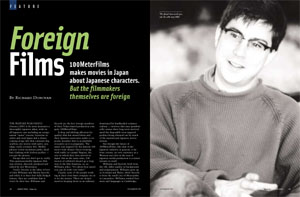 THE FEATURE FILM FIREFLY Dreams (2001) is by most measures a thoroughly Japanese affair, with its all-Japanese cast including an octogenarian "name" actress, locations in urban and rural Japan and a classic coming-of-age tale that contrasts hip, soulless city streets with naive, nostalgic inaka (country life). Mobile phones versus mountain paths, dyed hair clashing with daikon pickles -- you get the picture.
THE FEATURE FILM FIREFLY Dreams (2001) is by most measures a thoroughly Japanese affair, with its all-Japanese cast including an octogenarian "name" actress, locations in urban and rural Japan and a classic coming-of-age tale that contrasts hip, soulless city streets with naive, nostalgic inaka (country life). Mobile phones versus mountain paths, dyed hair clashing with daikon pickles -- you get the picture.
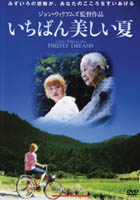 Clearly, none of the people working at their close-knit company are in it for the money. There are deeper motives keeping them in an industry dominated by hardheaded commercialism -- motives that may paradoxically ensure their long-term survival amid the disposable teen-targeted product being churned out by much of the mainstream Japanese movie system.
Clearly, none of the people working at their close-knit company are in it for the money. There are deeper motives keeping them in an industry dominated by hardheaded commercialism -- motives that may paradoxically ensure their long-term survival amid the disposable teen-targeted product being churned out by much of the mainstream Japanese movie system.
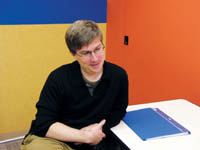 At Cambridge, he put the concept into action, making 8mm shorts between studying sessions. Many people discouraged him from pursuing a career in film, saying it wasn't financially viable. Williams recalls an incident that both drove the reality of this home to him and effectively drove him out of the country. "I knocked on the Welsh director Karl Francis's door and asked him if I could make coffee on the set of his next film. I was willing to do anything. He said, 'I don't know if I'll make another film in my life. Get out of this country!'"
At Cambridge, he put the concept into action, making 8mm shorts between studying sessions. Many people discouraged him from pursuing a career in film, saying it wasn't financially viable. Williams recalls an incident that both drove the reality of this home to him and effectively drove him out of the country. "I knocked on the Welsh director Karl Francis's door and asked him if I could make coffee on the set of his next film. I was willing to do anything. He said, 'I don't know if I'll make another film in my life. Get out of this country!'"
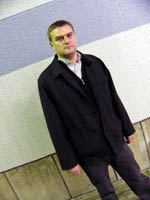 When the pair met at their language school, Williams was already making 8 millimeter films with Japanese students. Though he was eventually offered a place at the prestigious New York University film school, he didn't have enough money to attend. Deciding to produce something rather than wait to be taught, he sank his savings into an ambitious if amateurish 65-minute thriller called Midnight Spin, shot on the streets of Nagoya with higher quality, more expensive 16 millimeter film stock. The piece proved so costly that he went into multimillion yen debt to finance it. "It was only afterwards that I started to think seriously about what happened when a film is finished -- oh yeah, there are things like distribution and marketing! I'd just thought you made films, someone noticed you, then gave you lots of money."
When the pair met at their language school, Williams was already making 8 millimeter films with Japanese students. Though he was eventually offered a place at the prestigious New York University film school, he didn't have enough money to attend. Deciding to produce something rather than wait to be taught, he sank his savings into an ambitious if amateurish 65-minute thriller called Midnight Spin, shot on the streets of Nagoya with higher quality, more expensive 16 millimeter film stock. The piece proved so costly that he went into multimillion yen debt to finance it. "It was only afterwards that I started to think seriously about what happened when a film is finished -- oh yeah, there are things like distribution and marketing! I'd just thought you made films, someone noticed you, then gave you lots of money."
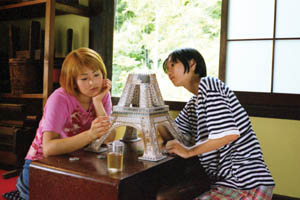 Rycroft's hunch was borne out when that potential, still very much in the rough as Williams readily admits, crystallized over the course of the next four years into Firefly Dreams. For what was to become the project that defined his company, Williams knew they had to take a more professional approach from the start.
Rycroft's hunch was borne out when that potential, still very much in the rough as Williams readily admits, crystallized over the course of the next four years into Firefly Dreams. For what was to become the project that defined his company, Williams knew they had to take a more professional approach from the start.
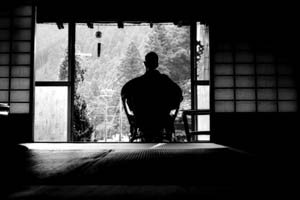 Williams, inspired by the predicament of a headstrong schoolgirl acquaintance in Nagoya, set out to tell the story of an adolescent's psychosocial development in Japan. His script featured Japanese characters but was written in English. A friend translated it into Japanese, then various other people worked on it, and finally the actors themselves made substantial revisions from the extensive rehearsal period right up to the start of shooting.
Williams, inspired by the predicament of a headstrong schoolgirl acquaintance in Nagoya, set out to tell the story of an adolescent's psychosocial development in Japan. His script featured Japanese characters but was written in English. A friend translated it into Japanese, then various other people worked on it, and finally the actors themselves made substantial revisions from the extensive rehearsal period right up to the start of shooting.
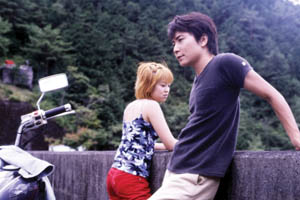 "I was sitting in a bar in Nagoya," Williams says, "recording wild (background) sound for Midnight Spin, and this louche-looking guy sits on the barstool next to me, and says, 'What are you doing?' I thought, I don't want to get into a fight with this guy. He says, 'I'm a musician.' He was a (Royal) marine, and he didn't look like a musician, but he insisted he was. He said, 'Come back to my place,' and it turned out he was a jazz musician, and really good. Then he said, 'I write symphonies,' and he played me one, and I was just blown away. Finally he said, 'If you do something else, I'd like to write a score for it.' So I took him up on the offer." Rowe was also able to bring in the talents of Japanese musicians in Nagoya for parts of the soundtrack.
"I was sitting in a bar in Nagoya," Williams says, "recording wild (background) sound for Midnight Spin, and this louche-looking guy sits on the barstool next to me, and says, 'What are you doing?' I thought, I don't want to get into a fight with this guy. He says, 'I'm a musician.' He was a (Royal) marine, and he didn't look like a musician, but he insisted he was. He said, 'Come back to my place,' and it turned out he was a jazz musician, and really good. Then he said, 'I write symphonies,' and he played me one, and I was just blown away. Finally he said, 'If you do something else, I'd like to write a score for it.' So I took him up on the offer." Rowe was also able to bring in the talents of Japanese musicians in Nagoya for parts of the soundtrack.
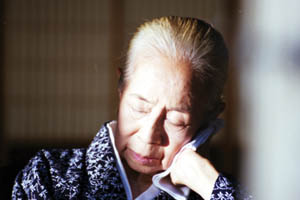 "I was drinking maitais with John before the ceremony," says Rycroft over a martini at a friend's bar in Nagoya. "We thought: We're not going to win this, because the first Hawaiian film ever was in competition, and also Fast Runner (starring Robert Carlisle), which had just won over in Cannes for best first feature. We were pretty tanked up when we got to the ceremony." Soon they were brimming with unexpected success.
"I was drinking maitais with John before the ceremony," says Rycroft over a martini at a friend's bar in Nagoya. "We thought: We're not going to win this, because the first Hawaiian film ever was in competition, and also Fast Runner (starring Robert Carlisle), which had just won over in Cannes for best first feature. We were pretty tanked up when we got to the ceremony." Soon they were brimming with unexpected success.
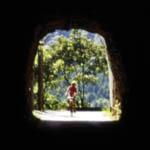 While Rycroft had learned a great deal from the travails of producing his first feature, Williams decided he needed to hone his own logistical skills to temper the literary excesses that had bloated the script. In 2002, after Williams moved the 100MeterFilms' office to Tokyo (leaving Rycroft behind in Nagoya), the director packed himself off to EAVE, the European Audiovisual Entrepre-neurs program.
While Rycroft had learned a great deal from the travails of producing his first feature, Williams decided he needed to hone his own logistical skills to temper the literary excesses that had bloated the script. In 2002, after Williams moved the 100MeterFilms' office to Tokyo (leaving Rycroft behind in Nagoya), the director packed himself off to EAVE, the European Audiovisual Entrepre-neurs program.
 Williams, who was nominated for a Best New Director award by the Japanese Society of Directors in 2002, acknowledges that his company is a rarity. But he claims that being a Westerner working in the Japanese film industry has not been an insurmountable challenge. "Film production is difficult for anyone in Japan. Lots of talented young Japanese directors somehow manage to make their first feature, but then they get stuck, because getting on with the second and doing it within the industry structure is a much more difficult thing." Williams knows that his follow-up effort will be the measure of his directorial mettle, but he literally can't afford to sit around. "The main thing I learned on EAVE was there's a gap of several years between each film, then a gap of several years again before it starts to recoup. So how do you sustain yourself in the troughs of a production company's business cycle? There's only one way: to have some other kind of business that's hopefully related to film."
Williams, who was nominated for a Best New Director award by the Japanese Society of Directors in 2002, acknowledges that his company is a rarity. But he claims that being a Westerner working in the Japanese film industry has not been an insurmountable challenge. "Film production is difficult for anyone in Japan. Lots of talented young Japanese directors somehow manage to make their first feature, but then they get stuck, because getting on with the second and doing it within the industry structure is a much more difficult thing." Williams knows that his follow-up effort will be the measure of his directorial mettle, but he literally can't afford to sit around. "The main thing I learned on EAVE was there's a gap of several years between each film, then a gap of several years again before it starts to recoup. So how do you sustain yourself in the troughs of a production company's business cycle? There's only one way: to have some other kind of business that's hopefully related to film."
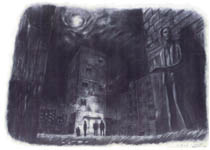 Recently the Dutch location crew for Paradise Girls described 100MeterFilms' logistical coordination as the smoothest they'd ever experienced, citing the talents of general manager Tsuyoshi Toyama and producer Misako Furukawa (who previously worked on two of British director Peter Greenaway's films).
Recently the Dutch location crew for Paradise Girls described 100MeterFilms' logistical coordination as the smoothest they'd ever experienced, citing the talents of general manager Tsuyoshi Toyama and producer Misako Furukawa (who previously worked on two of British director Peter Greenaway's films).



